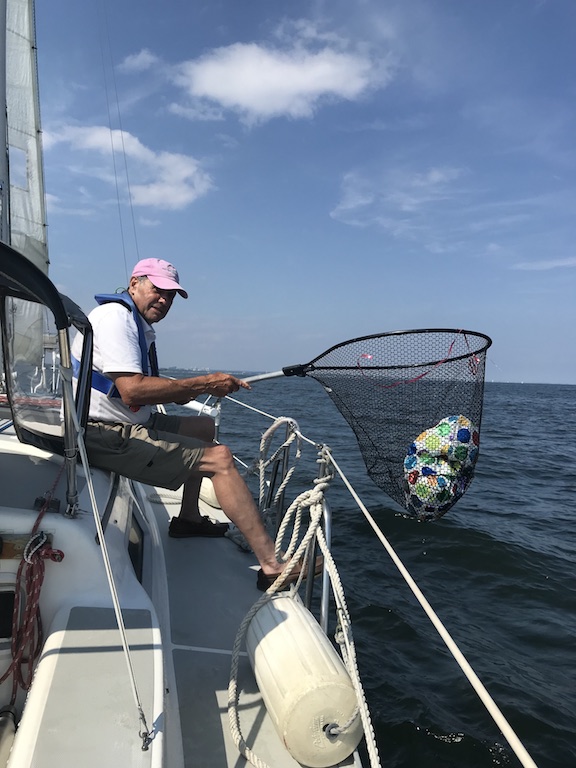By Ronnie Ross

On patrol are Gary Silberberg – the leader in Singles Under Sail’s search for balloons – and Teresa Nilla. © singlesundersail.org
Singles Under Sail, an active group of sailors and folks who love Long Island Sound, has been busy fishing. No, not for fish, but for balloons!!! Every time one of our boats is out sailing, we look for and scoop up balloons – the number we find is astounding! Last Saturday, five people sailing near Greenwich, CT on two boats collected 19 Mylar balloons in just two hours!
Balloons are a fun way to commemorate a big event or decorate a party, but considering the impact they have on ecosystems, you might want to think twice before buying them. Blue Ocean Society researchers have been recording debris observed from whale watch boats off the New England coasts for over eight years, and balloons have become the most common debris over the last five years! A recent report from The Ocean Conservancy has ranked balloons as one of the top three deadliest forms of litter, only behind discarded fishing nets and plastic bags.
All airborne balloons fall back down to Earth where they can wreak havoc on land, sea, and air. When helium balloons are released, they reach high altitudes, only to pop and fall back down. In the ocean, the end result is a jellyfish-looking balloon carcass which is just too tempting for a lot of sea creatures. For marine animals, balloons may mean death. They are ingested by whales, dolphins, turtles, seals, fish and waterfowl, all of which innocently believe they are food. Scientists who work with stranded sea creatures have found balloons, parts of balloons and balloon string in the stomachs of many of these dead animals, as ingested balloons block their intestines and eventually the animal starves to death. The ribbons can also become wrapped around animals as they swim in the water, which may hinder their ability to move or eat freely.
Recently, researchers have seen devastating evidence of what balloons can do to terrestrial wildlife as well. Cows, dogs, sheep, tortoises, birds and other animals have all been hurt or killed by balloons blocking their digestive tract, leaving them unable to take in nutrients, causing them to slowly starve to death. Aside from being ingested, their ribbons and tassels form the perfect trap for land animals to become entangled, struggle and then die. Balloon ribbons cause problems when they are picked up by birds, such as osprey, as nesting material. The ribbons in nests can get wound around the birds or nestlings, causing death by strangulation or starvation.
Mylar balloons are even less friendly to the environment. They are made from metallicized polyester, which is dirty in both production and disposal. In addition to the problems listed above, they also cause dangerous power outages. SafeElectricity.org reports that each year, hundreds of thousands of consumers experience power outages caused by Mylar balloons contacting electrical equipment.
Helium balloons can travel thousands of miles and pollute the most remote and pristine places. One that was unleashed in a science fair experiment to investigate wind direction was retrieved on an island 1,300 miles from its release site (reported by The National Oceanic and Atmospheric Administration). A report found on the EPA website titled “Ocean Conservancy Beach Debris Data” shows thousands of balloons pulled from waterways and coastlines every year.

Gary boats another one. © singlesundersail.org
All released balloons, whether they are released intentionally or not, return to Earth as litter, including those marketed as “biodegradable latex.” Latex balloons float for just ten hours, but can take a year or more to degrade, long enough to wrap around or be ingested by sea birds and marine mammals. Here’s what you can do to help our wildlife and our environment:
• Never release a balloon into the air.
• Pick up any balloons or ribbons you find and dispose of them properly (see below)
• Instead of balloons, use colorful honeycomb-shaped paper spheres, paper streamers, etc.
Don’t think that if you live far from the sea you are exempted! Balloons can travel hundreds of miles. If you do end up with a balloon, when done with it, please make sure to pop it and dispose of it properly (cut the string/ribbon off, cut it up and put it into a trash container), but, know that it will end up in a landfill, where it joins the never-ending pile of non-biodegradable plastics!
Check out singlesundersail.org for more of what we are doing. ■
Ronnie Ross is Singles Under Sail’s Public Relations Director.
